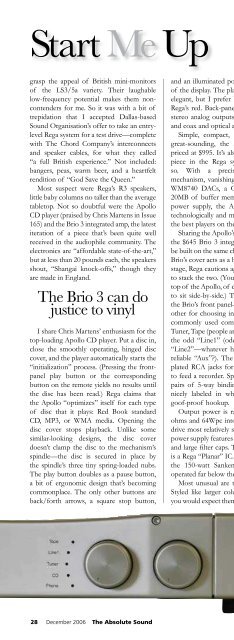You also want an ePaper? Increase the reach of your titles
YUMPU automatically turns print PDFs into web optimized ePapers that Google loves.
Start Me Up<br />
Rega Brio 3 Integrated Amplifier,<br />
R3 Loudspeaker, and Apollo CD Player<br />
grasp the appeal of British mini-monitors<br />
of the LS3/5a variety. Their laughable<br />
low-frequency potential makes them noncontenders<br />
for me. So it was with a bit of<br />
trepidation that I accepted Dallas-based<br />
Sound Organisation’s offer to take an entrylevel<br />
Rega system for a test drive—complete<br />
with The Chord Company’s interconnects<br />
and speaker cables, for what they called<br />
“a full British experience.” Not included:<br />
bangers, peas, warm beer, and a heartfelt<br />
rendition of “God Save the Queen.”<br />
Most suspect were Rega’s R3 speakers,<br />
little baby columns no taller than the average<br />
tabletop. Not so doubtful were the Apollo<br />
CD player (praised by Chris Martens in Issue<br />
165) and the Brio 3 integrated amp, the latest<br />
iteration of a piece that’s been quite well<br />
received in the audiophile community. The<br />
electronics are “affordable state-of-the-art,”<br />
but at less than 20 pounds each, the speakers<br />
shout, “Shangai knock-offs,” though they<br />
are made in England.<br />
The Brio 3 can do<br />
justice to vinyl<br />
I share Chris Martens’ enthusiasm for the<br />
top-loading Apollo CD player. Put a disc in,<br />
close the smoothly operating, hinged disc<br />
cover, and the player automatically starts the<br />
“initialization” process. (Pressing the frontpanel<br />
play button or the corresponding<br />
button on the remote yields no results until<br />
the disc has been read.) Rega claims that<br />
the Apollo “optimizes” itself for each type<br />
of disc that it plays: Red Book standard<br />
CD, MP3, or WMA media. Opening the<br />
disc cover stops playback. Unlike some<br />
similar-looking designs, the disc cover<br />
doesn’t clamp the disc to the mechanism’s<br />
spindle—the disc is secured in place by<br />
the spindle’s three tiny spring-loaded nubs.<br />
The play button doubles as a pause button,<br />
a bit of ergonomic design that’s becoming<br />
commonplace. The only other buttons are<br />
back/forth arrows, a square stop button,<br />
28 December 2006 The Absolute Sound<br />
and an illuminated power switch to the left<br />
of the display. The player’s look is clean and<br />
elegant, but I prefer blue LED displays to<br />
Rega’s red. Back-panel connections include<br />
stereo analog outputs on RCA connectors,<br />
and coax and optical audio outputs.<br />
Simple, compact, easy to operate, and<br />
great-sounding, the Apollo is reasonably<br />
priced at $995. It’s also the most expensive<br />
piece in the Rega system, and justifiably<br />
so. With a precision disc transport<br />
mechanism, vanishingly low jitter, Wolfson<br />
WM8740 DACs, a Class A output stage,<br />
20MB of buffer memory, and an overbuilt<br />
power supply, the Apollo competes both<br />
technologically and musically with some of<br />
the best players on the market.<br />
Sharing the Apollo’s dimensions and style,<br />
the $645 Brio 3 integrated amp appears to<br />
be built on the same chassis. But because the<br />
Brio’s cover acts as a heat sink for its output<br />
stage, Rega cautions against the natural urge<br />
to stack the two. (You can’t put anything on<br />
top of the Apollo, of course, so the two need<br />
to sit side-by-side.) Two large knobs grace<br />
the Brio’s front panel—one for volume, the<br />
other for choosing inputs, each labeled for<br />
commonly used components: Phono, CD,<br />
Tuner, Tape (people are still using tape), and<br />
the odd “Line1” (odd because there is no<br />
“Line2”—whatever happened to good old<br />
reliable “Aux”). The back panel has goldplated<br />
RCA jacks for all inputs, and a pair<br />
to feed a recorder. Speaker outputs are two<br />
pairs of 5-way binding posts. Everything’s<br />
nicely labeled in white against black for<br />
goof-proof hookup.<br />
Output power is rated at 49Wpc into 8<br />
ohms and 64Wpc into 4 ohms—enough to<br />
drive most relatively sensitive speakers. The<br />
power supply features a toroidal transformer<br />
and large filter caps. The amp’s phonostage<br />
is a Rega “Planar” IC. In a nod to reliability,<br />
the 150-watt Sanken output devices are<br />
operated far below their limits.<br />
Most unusual are the $845 R3 speakers.<br />
Styled like larger columns—from pictures,<br />
you would expect them to stand at least fourfeet<br />
tall—they have a 4" paper midrange at<br />
the top, with a 1" dome tweeter below it.<br />
A side-firing 5" woofer handles the bass,<br />
augmented by a 2.5" port in the bottom<br />
front of the speaker. (Front ports enable<br />
placement of speakers closer to walls.) The<br />
back panel has a single pair of 5-way binding<br />
posts; the contrasting plinth has threaded<br />
recesses for spike feet.<br />
The test drive happened to coincide with<br />
a home invasion by a team of plasterers<br />
and painters, the outcome of a summit<br />
meeting with my mate over living in a<br />
perpetual remodel. I’ve had to swallow my<br />
perfectionist do-it-yourself pride and admit<br />
that even if I can do everything myself—and<br />
better than anyone else—I can’t do it within<br />
any reasonable time frame. So my main<br />
system went into hibernation, draped in<br />
plastic sheeting, and the Rega system got set<br />
up in the small back bedroom that serves as<br />
my office—actually an appropriate space for<br />
it, considering the domestic environments<br />
likely to house it. Most folks outside North<br />
America live in much smaller spaces than we<br />
do.<br />
Truthfully, I wasn’t expecting much from<br />
the R3s, and I was pleasantly surprised to<br />
discover that not only do they not have<br />
British mini-monitor syndrome (excessively<br />
lean bass), they actually have amazingly<br />
good bass, with excellent pitch definition.<br />
Imaging was also a surprise. With the R3s<br />
about six feet apart, and a foot off the wall, I<br />
was able to sit ten feet away and get a pretty<br />
good sense of dimensionality from a big<br />
range of recordings—including a few LPs.<br />
I have an old Rega Planar 2 turntable, with a<br />
Sumiko Blue Point high-output moving-coil<br />
cartridge. My vinyl days are long behind me,<br />
but I hooked it up to see how it sounded,<br />
and found the results delightful, especially<br />
with high-quality recordings like some of<br />
Mobile Fidelity’s remasters. The Brio 3 can<br />
do justice to vinyl, boding well not only<br />
for old-school music fans, but for the new<br />
generation just discovering the format.<br />
A tad astringent when first powered up,<br />
the Rega system needed a lengthy warm<br />
up before it began to really breathe. Strunz<br />
& Farah’s Americas [Mesa] didn’t begin to<br />
feel articulate and dynamic until about<br />
20 minutes in, but then the system began<br />
to open up. Physically modest, the Rega<br />
system has a sonic signature that seems<br />
bigger, like a shadow cast late in the day.<br />
While I couldn’t push it into the “red zone”<br />
without needing to dial back the volume,<br />
it did well at moderate to moderately loud<br />
levels—perfectly adequate for a small room.










